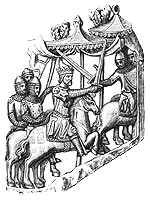
De Re Militari | Book Reviews
David Nicolle
Fighting for the Faith:
The Many Fronts of Crusade and Jihad 1000-1500 AD
South Yorkshire, England: Pen & Sword, 2007. 224 pp. £19.99 ($39.95). ISBN 1844156146.

West against East. Crusader against Jihadi. Bush against bin Laden. Just 10 words that arguably spring to mind when confronted with David Nicolle’s Fighting for the Faith. Yet an introduction in and already such thinking would appear to be supremely naïve. Still do not recent events support such thinking? (Even the back cover of Nicolle’s similarly-themed, similarly-timed Crusader Warfare: Byzantium, Western Europe and the Battle for the Holy Land reasons that, “To a large extent the current interest in the Crusades reflects the perceived threat of a so-called ‘clash of civilizations’… [in which] some now look to the medieval Crusades as an earlier example of such conflict.”)
In the first video to appear on al-Jazeera since the September 11 atrocities (October 7, 2001), Ayman al-Zawahiri played the ‘Crusade’ card:
“A new epoch in the history of Islam has begun… a new battle for the faith like the battles of Hattin, of Ain Jalut [the victory in 1260 over the Mongols] and the conquest of Jerusalem.”
George W. Bush likewise alluded to the historical Crusades. The president’s parallel was announced just five days after the attacks and weeks before that of the Egyptian paediatrician turned Islamist cave-dweller.
Commentators continue to historicize that the fallout from 9/11 is another Crusader state in the heart of the dar al-Islam. And this after Saddam (in the spirit of Saladin) had confronted George H. W. Bush (resembling Godfrey of Bouillon or Reginald of Châtillon) in the Gulf War (comparable to the battle of Hattin).
Library shelves groan under the weight of tomes illuminating parallels between then and now. For that reason, surely a reader would be forgiven for believing Nicolle’s book to be much more of the same—thus expanding on our 10 words? Yet to any follower of his works, which are as numerable as they are encyclopaedic in nature (Crusader Warfare: Muslims, Mongols and the Struggle Against the Crusades and Warriors and Their Weapons Around the Time of the Crusades: Relationships Between Byzantium, the West and the Islamic World), such a presupposition would not only be erroneous but one for which no Nicolle-aficionado could be forgiven.
For readers wanting to read one of Pope Urban II’s speeches, look elsewhere. The same goes for those students expecting tales of the legendary Tancred. Saladin remains conspicuous by his near-total absence. As does Richard ‘The Lionheart’ of England. As a result, think more William H. McNeill’s The Pursuit of Power: Technology, Armed Force, and Society since A.D. 1000 than Christopher Tyerman’s God’s War: A History of the Crusades or Anthony Pagden’s recently-released Worlds at War: The 2,500-Year Struggle between East and West.
Long before the book’s end the reader will appreciate that the 10 opening words have very little to do with Nicolle’s handy hardback. Recruitment, mercenaries, marine warfare, war-elephants and a fourteenth-century ‘arms race’ are 10 words that prove far more apposite. In truth, Fighting for the Faith is a wide-ranging, indeed pioneering, survey of (un)holy war across the entirety of the medieval world. So wide-ranging, in fact, that Jerez is as likely to feature as Jerusalem, Athens as much as Aleppo and Belgrade more than Baghdad.
Fighting for the Faith does not solve the problems of the present, but its grand synthesis—both historically and geographically speaking—provides an original understanding of the phenomenon of holy war. Fighting for the Faith is evidently the work of one of the most brilliant medievalists of his generation and one with a clear paraphrastic gift. (The reviewer holding the publishing house, not the author, responsible for the litany of grammatical errors: pp. 13, 14, 38, 47, 74, 82-83, 113 & 152.) All 10 chapters are relatively crisp, omitting history a novice historian would more than likely incorporate—much to the detriment of his/her thesis. Nine maps at the outset coupled with 40 black and white illustrations after the book’s midpoint only adds to the title’s worth. Add to that a five-page glossary and what we have is a truly accessible text. That said Nicolle’s latest work is for the specialist, and for the specialist alone. With its graphic account of the struggle for mastery of the waves throughout the medieval world and deeply penetrating analysis of the organization and tactics of Christian and Muslim armies, not to mention discussions pertaining to Andalusian-Maghrebi fortifications, Fighting for the Faith is beyond the reach of the merely interested reader.

Lee Ruddin
Independent Scholar <[email protected]>
Page Added: April 2008